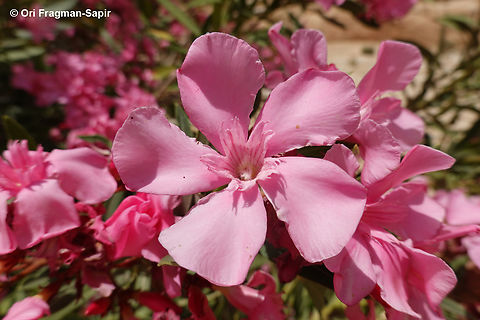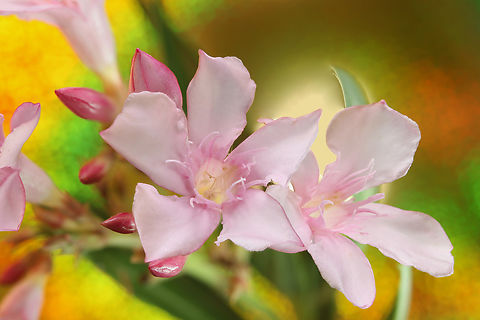
Appearance
Oleander grows to 2–6 m tall, with erect stems that splay outward as they mature; first-year stems have a glaucous bloom, while mature stems have a grayish bark. The leaves are in pairs or whorls of three, thick and leathery, dark-green, narrow lanceolate, 5–21 cm long and 1–3.5 cm broad, and with an entire margin. The flowers grow in clusters at the end of each branch; they are white, pink to red, 2.5–5 cm diameter, with a deeply 5-lobed fringed corolla round the central corolla tube. They are often, but not always, sweet-scented. The fruit is a long narrow capsule 5–23 cm long, which splits open at maturity to release numerous downy seeds.
Naming
Oleander grows well in warm subtropical regions, where it is extensively used as an ornamental plant in landscapes, in parks, and along roadsides. It is drought-tolerant and will tolerate occasional light frost down to −10 °C. It is commonly used in landscaping freeway medians in California, Texas and other mild-winter states in the Continental United States because it is upright in habit and easily maintained. Its toxicity renders it deer-resistant. It is tolerant of poor soils and drought. Oleander can also be grown in cooler climates in greenhouses and conservatories, or as indoor plants that can be kept outside in the summer. Oleander flowers are showy and fragrant and are grown for these reasons. Over 400 cultivars have been named, with several additional flower colours not found in wild plants having been selected, including red, purple, pink, and orange; white and a variety of pinks are the most common. Many cultivars also have double flowers. Young plants grow best in spaces where they do not have to compete with other plants for nutrients.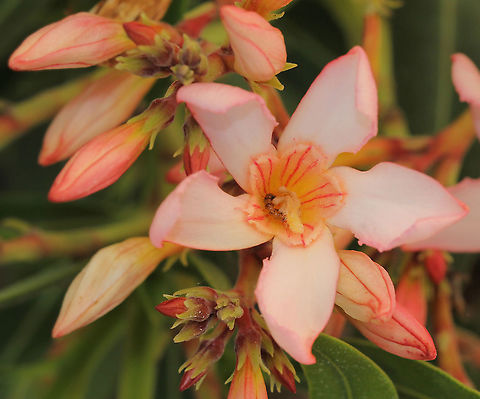
Habitat
"N. oleander" is either native or naturalized to a broad area from Mauritania, Morocco, and Portugal eastward through the Mediterranean region and the Sahara, to the Arabian peninsula, southern Asia, and as far East as Yunnan in southern parts of China. It typically occurs around dry stream beds. "Nerium oleander" is planted in many subtropical and tropical areas of the world. On the East Coast of the US, it can be planted as far north as Virginia Beach, Virginia, while in California and Texas it is naturalized as a median strip planting.Some invertebrates are known to be unaffected by oleander toxins, and feed on the plants. Caterpillars of the Oleander or Polka-Dot Wasp Moth feed specifically on oleanders and survive by eating only the pulp surrounding the leaf-veins, avoiding the fibers. Larvae of the Common Crow Butterfly also feed on oleanders. The Common Crow larvae retain or modify toxins, making them unpalatable to would-be predators such as birds, but not to other invertebrates such as spiders and wasps.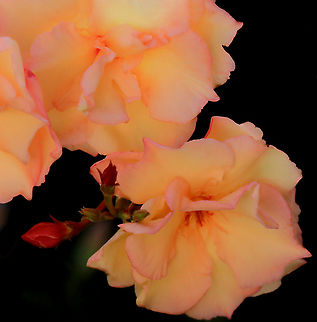
Defense
"Nerium oleander" has historically been considered a poisonous plant because some of its compounds may exhibit toxicity, especially to animals, when consumed in high amounts. Among these compounds are oleandrin and oleandrigenin, known as cardiac glycosides, which are known to have a narrow therapeutic index and can be toxic when ingested.Toxicity studies of animals administered oleander extract concluded that rodents and birds were observed to be relatively insensitive to oleander cardiac glycosides. Other mammals, however, such as dogs and humans, are relatively sensitive to the effects of cardiac glycosides and the clinical manifestations of "glycoside intoxication".
However, despite the common "poisonous" designation of this plant, very few toxic events in humans have been reported. According to the Toxic Exposure Surveillance System in 2002 there were 847 human exposures to oleander reported to poison centers in the United States. Despite this exposure level, from 1985 through 2005, only three deaths were reported. One cited death was apparently due to the ingestion of oleander leaves by a diabetic man. His blood indicated a total blood concentration of cardiac glycosides of approximately 20 μg/L which is well above the reported fatal level. Another study reported on the death of a woman who self-administered "an undefined oleander extract" both orally and rectally and her oleandrin tissue levels were 10 to 39 μg/g which were in the high range of reported levels at autopsy. And, finally, one study reported the death of a woman who ingested oleander 'tea'. Few other details were provided.
In contrast to consumption of these undefined oleander derived materials, there is no toxicity or deaths reported from topical administration or contact with "Nerium oleander" or specific products derived from them. In reviewing oleander toxicity Lanford and Boor concluded that, except for children who might be at greater risk, "the human mortality associated with oleander ingestion is generally very low, even in cases of moderate intentional consumption ".
Toxicity studies that have been conducted in dogs and rodents administered oleander extracts by intramuscular injection indicated that on an equivalent weight basis, doses of an oleander extract with glycosides ten times in excess of those likely to be administered therapeutically to humans are still safe and without any "severe toxicity observed".
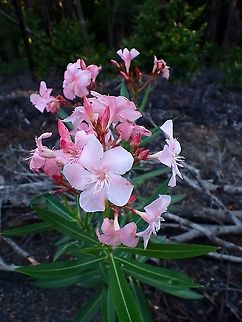
Evolution
In his book "Enquiries into Plants" of ca. 300 BC, Theophrastus described, a shrub he called "onotheras", which modern editors render oleander; "the root of "onotheras" [oleander] administered in wine," he alleges, "makes the temper gentler and more cheerful".The plant has a leaf like that of the almond, but smaller, and the flower is red like a rose. The plant itself forms a large bush; the root is red and large, and, if this is dried, it gives off a fragrance like wine.
In another mention, of "wild bay", Theophrastus appears to intend the same shrub.
Willa Cather, in her book "The Song of the Lark", mentions oleander in the following passage:
This morning Thea saw to her delight that the two oleander trees, one white and one red, had been brought up from their winter quarters in the cellar. There is hardly a German family in the most arid parts of Utah, New Mexico, Arizona, but has its oleander trees. However loutish the American-born sons of the family may be, there was never one who refused to give his muscle to the back-breaking task of getting those tubbed trees down into the cellar in the fall and up into the sunlight in the spring. They may strive to avert the day, but they grapple with the tub at last.
Oleander is the official flower of the city of Hiroshima, having been the first to bloom following the atomic bombing of the city in 1945.
References:
Some text fragments are auto parsed from Wikipedia.
